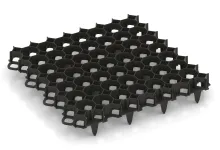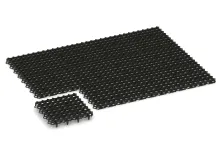Fitness Floor Protection Mat HD TZ "Anthracite"
- /
-
Delivery in approx.
7-14 days - £45.10 / 1 Piece / m²
- (26.03 kg / Piece)
EAN: 4251469333307 | Item no.: 3330
The WARCO Fitness Floor Protection Mat HD is the particularly robust solution for heavily used training areas indoors. Thanks to its high density, precise moulding and solid material thickness, it reliably protects subfloors, equipment and athletes – in professional gyms as well as in home gyms.
High density – strong load capacity
The mats are made of PU-bonded rubber granulate and are available in thicknesses of 3, 4 or 5 cm. Due to their high density, they provide good pressure stability, low deformation and good abrasion resistance. This makes them ideal for areas where weights, equipment and intensive training forms are used.
Moulded puzzle interlock with bevel
Each mat features a precisely moulded puzzle interlock that is easy to connect with a perfect fit. The surrounding bevel ensures a clean, orderly joint pattern and gives the surface a high-quality appearance. The result is a stable, form-fitting carpet of tiles.
Application – indoors & temporary outdoors
The Fitness Floor Protection Mat HD is specifically designed for indoor use. Outdoors, it is suitable only for temporary use, for example at events or exhibitions.
Easy installation and maintenance
The mats can be laid quickly and easily without adhesive. If required, individual elements can be replaced or repositioned. Maintenance is straightforward – vacuuming, sweeping or wiping with standard cleaning agents is sufficient.
Quality from the manufacturer
The Fitness Floor Protection Mat HD is robust, durable, hygienic and toxicologically safe. It combines high density, good stability and a neat appearance – ideal for heavily used training areas in studios and home gyms.
Discount
Product Highlights
Characteristics
Product Details – Material and Structure
Comparative values
To calculate how many tiles you need for your project, simply use the online installation planner available in the shop. This free browser-based tool is directly accessible on each product page – just below the price and quantity selection. Click on “Plan installation” to open the tool instantly – no registration or download required.
Enter the dimensions of your area, such as the length and width in metres. The planner will then automatically calculate the total number of tiles required, including a realistic allowance for offcuts. You’ll also be shown a suitable layout pattern for the selected product. The tool is user-friendly, accurate and ideal for planning your material requirements with confidence.
Yes, that is the standard approach. The vast majority of our customers – whether private, municipal, or commercial – install the delivered WARCO tiles themselves or with their own staff. The installation is simple and requires no special skills. Only fitting the curb into a concrete foundation with back support demands a little extra craftsmanship. Cutting the elements to size and laying them on a suitable substrate is not challenging. You can find all essential installation information in our Expert Advice – FAQ section on our website.
WARCO offers several connection systems for floor tiles, each differing in design, installation method and visual appearance. Below is an overview of the key differences:
Puzzle joint (visible)
In this system, the tile edges feature an interlocking profile reminiscent of classic jigsaw teeth or mushroom-shaped connectors. During installation, the profiles of adjacent tiles interlock to form a continuous connection across the full tile thickness.
The joint profile may be formed directly during pressing or precisely cut after the tile has cured. Whether the joint is visible in the finished surface depends on the edge finish (e.g. with or without chamfer) and the surface colouration.
The symmetrical shape ensures uniform load transfer and makes this type of joint the most mechanically stable option.
Plug-in connectors (plastic dowels)
This system uses separate connecting elements, typically round plastic dowels, which are inserted into pre-drilled holes along the sides of the tiles. The tiles themselves have smooth, straight edges similar to precast concrete slabs.
Installation is carried out in a half-bond (stretcher bond) pattern: each tile is connected via dowels to two tiles in the row above and two in the row below. This prevents lateral shifting, although some movement along the length of the dowels remains possible. For this reason, an edge restraint must be installed around the perimeter to stabilise the entire area.
Concealed puzzle joint
This method is based on the same mechanical principle as the classic puzzle joint, but is designed to be invisible in the finished surface. The interlocking profile is located on the underside of the tile, integrated into a rebated step joint.
Two tile edges feature a positive locking profile, the other two a matching negative profile. When laid, the tiles interlock securely from below, forming a durable mechanical connection. From above, the surface appears seamless and aligned, typically with a clean, square joint pattern similar to a chessboard layout.



















































